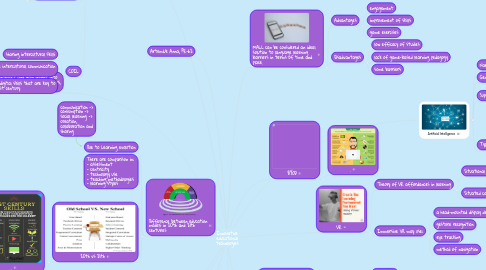
1. experience, interact and gain insight into cultural differences in human relationships, behavior and communication
2. A Heuristic is a technique to solve a problem faster than classic methods, or to find an approximate solution when classic methods cannot.
3. Cycle of Inquiry
3.1. Inquiry-based learing
3.1.1. students are encouraged to explore the material, ask questions, and share ideas.
3.1.2. it encourages children’s natural curiosity and sense of wonder about the world around them.
3.2. Inquiry-based teaching strategy
3.2.1. problem statement
3.2.2. data collection
3.2.3. analysis
3.2.4. conclusions
4. Difference between education models in 20th and 21th centuries
4.1. Due to Learning evolution
4.2. There are comparison in: - assessment - centricity - technology use - teaching methodologies - learning styles
4.3. 20th vs 21th
4.3.1. .
5. communication -> consumption -> social learning -> creation, collaboration and sharing
6. .
7. Heuristic technique
8. Team
8.1. According to Belbin:
8.1.1. thinking-oriented roles
8.1.1.1. plant: innovators&ideas
8.1.1.2. monitor evaluator: separate good ideas from bad
8.1.1.3. specialist: skills in a specialist job
8.1.2. action-oriented roles
8.1.2.1. shaper: challange norms, take lead, push team
8.1.2.2. implementer: executors of plans
8.1.2.3. completer finisher: complete the fine details
8.1.3. people-oriented roles
8.1.3.1. coordinator: natural team leaders
8.1.3.2. team worker: diplomats, keep team cogs turning
8.1.3.3. resource investigator: find external resources
8.2. Collaboration
8.2.1. Google Apps in FLC
8.2.1.1. Google Drive
8.2.1.2. Google Docs
8.2.1.3. Google Translate
8.2.1.4. Google Drawing
8.2.1.5. Google Forms
8.2.1.6. Google Presentations
8.2.1.7. Google Spreadsheets
8.2.1.8. Google Sites
8.2.1.9. Google Calendar
8.2.1.10. Google Groups
8.2.1.11. GMail
8.2.1.12. Blogger
8.3. COIL
8.3.1. sharing intercultural skills
8.3.2. increasing the intercultural communication capacity
8.3.3. development digital skills that are key to life in the 21st century
9. Artemiuk Anna, PR-62
10. 4 C's
11. Application of EdTech should facilitate learning
11.1. Learning theories:
11.1.1. Behaviorism
11.1.2. Constructivism
11.1.3. Cognitivism
11.1.4. Connevtivism
12. Mindset plays a great role
12.1. According to Carol Dweck
12.1.1. There are 2 types:
12.2. Your attitude is more important than your intelligence!
12.3. Components of mindset:
12.3.1. emotions
12.3.2. knowledge
12.3.3. opinions
12.3.4. assumptions
13. MALL can be considered an ideal solution to language learning barriers in terms of time and place.
13.1. Advantages
13.1.1. engagement
13.1.2. improvement of skills
13.1.3. game exercises
13.2. Disadvantages
13.2.1. low efficacy of studies
13.2.2. lack of game-based learning pedagogy
13.2.3. some barriers
14. BYOD
14.1. .
15. Artificial Intelligence
15.1. Narrow. Machine Learning
15.1.1. 1 area and 1 problem
15.2. General. Machine Intellegence
15.2.1. as smart as human
15.3. Super. Machine Consciousness
15.3.1. smarter than best brain
15.3.2. Machine Learning
15.4. Types of AI
15.4.1. Natural language processing
15.4.2. Speech
15.4.3. Expert systems
15.4.4. Planning
15.4.5. Robotics
15.4.6. Vision
16. VR
16.1. Theory of VR affordances in learning
16.1.1. Situational Cognition Theory
16.1.1.1. helps to explain the effectiveness of VR learning environments
16.1.2. Situated cognition or situated learning
16.1.2.1. focuses on the whole process of learning, outlines important implications for the design and development of classroom instruction
16.2. Immersive VR may use:
16.2.1. a head-mounted display device
16.2.2. gesture recognition
16.2.3. eye tracking
16.2.4. method of navigation
